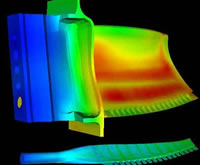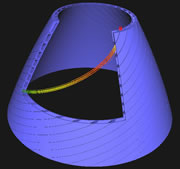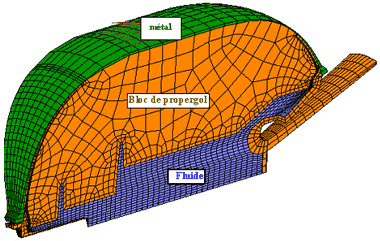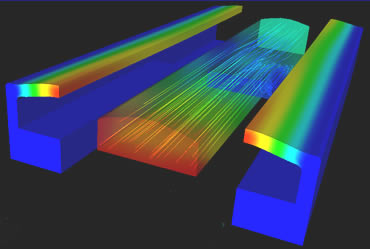The air deforms the structure of an aircraft, while the aircraft's vibrations modify the air flow. To take all of these phenomena into consideration, ONERA is developing models coupling fluid mechanics and solid mechanics.
Number 35
 Temperature calculation of a turbine blade where the wall and a cooling channel are taken into account, with coupling of "fluid" and "solid" software (Cedre and Abaqus resp.). |
In numerical simulations of aircraft, fluid mechanics specialists model the motion of air around the wings or in the engines, and structural mechanics researchers analyze the behaviour of the mechanical parts. But the air and the aircraft's structure are not unrelated: they interact with one another. The air flow deforms the wings, causing vibrations, which in turn modify the fluid flow. The complexity of these phenomena must be taken into consideration in "multi-phy" simulations. |
|
"Unfortunately, there is no universal calculation software”, regrets François-Xavier Roux, researcher at the ONERA "Modeling and Information Processing" Department (DTIM). "The fluid and mechanical structure calculations are already complex, and the same language isn't used in these fields, nor the same meshing (dividing space into small volumes, or elements) and it would thus be very complicated to create a new calculation code integrating both branches of physics". It is simpler to link existing software programs. "We do not know how to calculate both aspects at the same time”, the researcher points out. "That is why we carry out successive calculations with multiple round trips between the two calculation programs, introducing structure calculation information into fluid calculation and vice versa". These software programs operate simultaneously on a network of computers, and thus it is necessary to fine tune the data exchange between the machines.
|
|
|
Jean-Didier Garaud, PhD from the Solid Mechanics and Damage Mechanisms Department (DMSE) is interested, for example, in flow issues in the cooling circuit of the Vulcain2 engine of the Ariane launcher. This circuit is made up of hollow tubes with a rectangular cross section, coiled in a spiral around the nozzle wall and through which hydrogen circulates to cool the walls. Besides the motion of air and mechanical parts, it is necessary to take into consideration the heat exchanges, which also deform structures. If the deformation is too strong, the nozzle may break, or prevent the passage of fluids. "We have carried out calculations taking into consideration the thermal aspects”, says the researcher. "The result is satisfactory: we correctly reproduce the thermal exchanges, both in the steady and unsteady states (integrating the changes in time)". |
 Diagram of the upper part of the Vulcain nozzle, comprised of 288 tubes made of Inconel 600, in which hydrogen cools the wall. |
|
These calculations were carried out in this case by coupling fluid mechanics software developed by ONERA [Cedre], with a mechanics software [ZebuLoN] designed by ONERA in collaboration with Ecole des Mines in Paris. They were the subject of a thesis. A second thesis is underway dealing with the behaviour of the nozzle in the case of large deformations. "This is the type of service that industrialists expect of ONERA”, says François-Xavier Roux. "It is not just a case of being a specialist in a field, but also to give a global answer to a question. This is why it is of interest to be multi-disciplinary".
Cécile Michaut, scientific reporter. |
|






